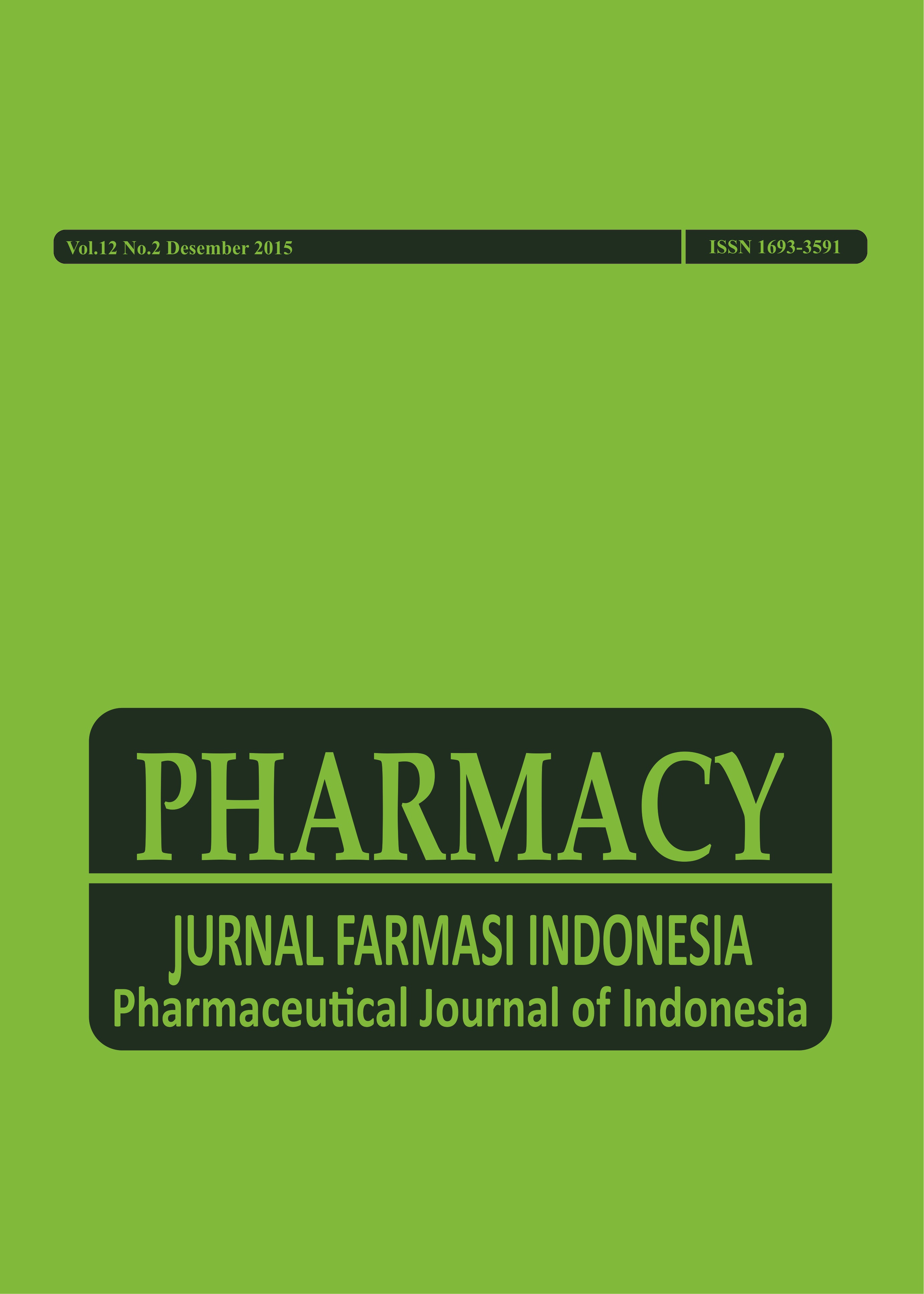EFEK ANTIHIPERGLIKEMIK DAN ANTIHIPERKOLESTEROL EKSTRAK TEMPE KACANG KOMAK (Lablab purpureus (L.) Sweet) PADA HAMSTER DIABETIK DIET TINGGI KOLESTEROL
DOI:
https://doi.org/10.30595/pji.v12i2.328Abstract
ABSTRAK Kacang komak (Lablab purpureus (L.) Sweet) mengandung senyawa aktif yang memiliki aktivitas sebagai antihiperglikemik dan antihiperkolesterol. Penelitian ini bertujuan untuk mengetahui efek ekstrak tempe kacang komak terhadap kadar glukosa darah, kolesterol total, dan LDL darah hamster yang diinduksi aloksan dan pakan tinggi kolesterol. Hewan uji hamster Syrian jantan dibagi 7 kelompok perlakuan. Dosis uji yang digunakan yaitu 280 mg/kg BB, 560 mg/kg BB, dan 1120 mg/kg BB secara peroral selama 14 hari. Kelompok kontrol positif diberikan glibenklamid dan atorvastatin. Berdasarkan hasil uji analisa statistik ANOVA satu arah (α<0,05) menunjukan bahwa ekstrak etanol tempe kacang komak memiliki kemampuan sebagai antihiperglikemik dan antihiperkolesterol. Kata kunci: antihiperglikemik, antihiperkolesterol, kacang komak, tempe. ABSTRACT Hyacinth bean (Lablab purpureus (L.) Sweet) contains active compounds with antihyperglycemic and antihipercholesterolemic activity. This research aims to determine the effect of extract of hyacinth bean tempeh on lowering blood glucose levels, total kolesterol, and LDL blood levels on male hamsters induced by high-cholesterol feed and alloxan. Research used male Syrian hamsters divided into 7 groups. The dose of extract of hyacinth bean tempeh were 280 mg/kg BW, 560 mg/kg BW, and 1120 mg/kg BW administered orally for 14 days. Positive control group were given glibenclamide and atorvastatin. The test results of one-way ANOVA statistical analysis (α<0.05) showed that the ethanolic extract of hyacinth bean tempeh have antihyperglycemic and antihypercholesterolemic activity. Key words: antihypercholesterolemic, antihyperglycemic, hyacinth bean, tempeh.References
Coward, L., Barnes, N., Setchell, K.D.R., Barnes, S. 1998. Genestein and deidzein and their ß-gliciside conjugates anti-tumor isoflavones in soybeans foods from American and Asian diets. Journal of Agricultural and Food, 41:1961-1967.
Depkes RI. 1997. Materia medika Indonesia. Jilid VI. Jakarta: Departemen Kesehatan Republik Indonesia. pp. 324, 333-337.
Dirjen POM. 2000. Buku panduan teknologi ekstrak. Jakarta: Direktorat Jenderal Pengawasan Obat dan Makanan. pp. 17, 22, 39.
Faradila, R.H.F. 2010. Profil dan peroksidasi lipid tikus percobaan setelah pemberian tepung tempe kacang komak (Lablab purpureus (L.) Sweet). Skripsi. Fakultas Teknologi Pertanian, Institut Pertanian Bogor, Bogor.
Fitria, N.A., Sidi, N.C., Safitri, R.K., Hasanah, A.N., Risni, T. 2013. Tempe daun pepaya sebagai alternatif terapi untuk penderita kanker. Jurnal Teknosains Pangan, 2(4):3-11.
Giri, N.L. 2008. Potensi antioksidasi daun salam: kajian in vivo pada tikus hiperkolesterolemia dan hiperglikemia. Skripsi. Fakultas MIPA, Institut Pertanian Bogor, Bogor.
Harnani, S. 2009. Studi karakteristik dan kapasitas antioksidan tepung tempe kacang komak (Lablab purpureus (L.) Sweet). Skripsi. Fakultas Teknologi Pertanian, Institut Pertanian Bogor, Bogor.
Hartoyo, A., Muchtadi, D., Astawan, M., Dahrulsyah, Winarto, A. 2011. Pengaruh ekstrak protein kacang komak (Lablab purpureus (L.) Sweet) pada kadar glukosa dan profil lipida serum tikus diabetes. Jurnal Teknologi dan Industri Pangan, XXI(1):58-63.
Human. 2012. Glucose Liquicolor. Germany: Human Gesellschaft for Biochemica and Diagnostica mbH.
Istiani, Y. 2010. Karakterisasi senyawa bioaktif isoflavon dan uji aktivitas antioksidan dari ekstrak etanol tempe berbahan baku koro pedang (Canavalia ensiformis). Tesis. Program Pasca Sarjana, Universitas Sebelas Maret Surakarta.
Kaneto, H., Kajimoto, Y., Miyagawa, J., Matsuoka, T., Fujitani, Y., Umayahara, Y., Hanafusa, T., Matsuzawa, Y., Yamasaki, Y., Hori, M. 1999. Beneficial effects of antioxidants in diabetes: possible protection of pancreatic beta cells against glucose toxicity. Diabetes, 48:2398-2406.
Kante, K., Reddy, C.S. 2013. Antidiabetic activity of Dolichos lablab (seeds) in streptozotocin-nicotinamide induced diabetic rats. Journal for Drugs and Medicines, 5(1):32-40.
Kwon, D.Y., Daily, J.W., Kim, H.J., Park, S. 2010. Antidiabetic effects of fermented soybean products on type 2 diabetes. Journal Nutrition Research, 30:1-13.
Martindale. 2002. The complete drugs referens. 33rd edition. London: Pharmaceutical Press. pp. 842-843.
Pramana, D.G. 2008. Efek pemberian ekstrak tempe terhadap kolesterol total dan profil lipoproten plasma darah kelinci (Oryctolagus cuniculus). Skripsi. Fakultas kedokteran Hewan IPB, Bogor.
Restuhadi, F. 2001. Studi pendahuluan biokonversi isoflavon pada proses fermentasi kedelai menggunakan Rhizopus spp. L.4l. Tesis. Magister Kimia ITB, Bandung.
Rifai, N. 2000. Handbook of lipoprotein testing. USA: American Association for Clinical Chemistry.
Royal Pharmaceutical Society. 2009. British national formulary. Edisi 58. London: Royal Pharmaceutical Society. pp. 382.
Schmidl, M.K. dan Labuza, T.P. 2000. Essential of functional foods. Maryland: Aspen Publisher Inc.
Spiegel, M.R. dan Stephens, L.J. 2007. Schaum’s outlines teori dan soal-soal statistik. Jakarta: Erlanggga. pp. 327-329.
Suarsana, I.N. 2009. Aktivitas hipoglikemik dan antioksidatif ekstrak metanol tempe pada tikus diabetes. Tesis. Sekolah Pascasarjana, Institut Pertanian Bogor, Bogor.
Triplitt, C.L., Reasner, C.A., Isley, W.L. 2008. Diabetes mellitus. Dalam: Dipiro et al. 2008. Pharmacotherapy: a pathophysiologic approach. 7th ed. US: Mc Graw Hill. pp. 1220.
Voight, R. 1995. Buku pelajaran teknologi farmasi. Terjemahan: Soewandhi. S.N. Yogyakarta: Universitas Gajah Mada. pp. 564.
Wade, A. dan Weller, P.J. (ed.). 1994. Handbook of pharmaceutical excipients. Edisi 2. London: The Pharmaceutical Press. pp. 78.
Yeap, S.K., Ali, N.M., Yusof, H.M., Alitheen, N.B., Beh, K.B., Ho, W.Y., Koh, S.P., Long, K. 2012. Antihyperglicemic effect of fermented and nonfermented mung bean extracts on alloxan induced diabetic mice. Journal of Biomedicine and Biotechnology. Article ID 285430:1-7
Downloads
Published
How to Cite
Issue
Section
License
Authors who publish with this journal agree to the following terms:
- Authors retain copyright and grant the journal right of first publication with the work simultaneously licensed under a Creative Commons Attribution 4.0 International License that allows others to share the work with an acknowledgement of the work's authorship and initial publication in this journal.
- Authors are able to enter into separate, additional contractual arrangements for the non-exclusive distribution of the journal's published version of the work (e.g., post it to an institutional repository or publish it in a book), with an acknowledgement of its initial publication in this journal.
- Authors are permitted and encouraged to post their work online (e.g., in institutional repositories or on their website) prior to and during the submission process, as it can lead to productive exchanges, as well as earlier and greater citation of published work (See The Effect of Open Access).






